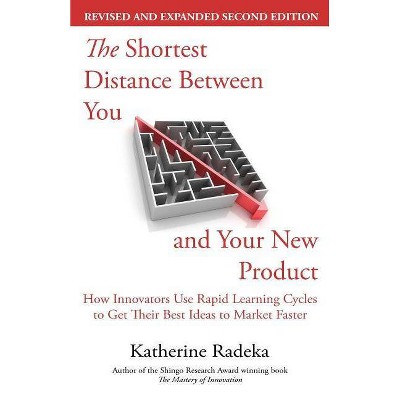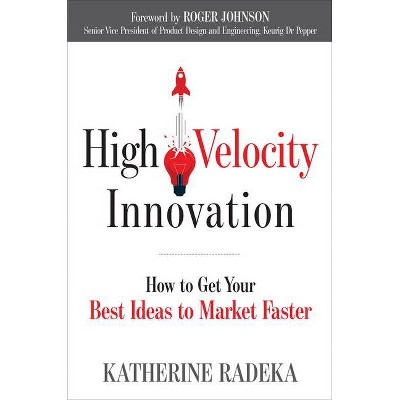The Shortest Distance Between You and Your New Product, 2nd Edition - by Katherine Radeka (Paperback)

Similar Products
Products of same category from the store
AllProduct info
<p/><br></br><p><b> About the Book </b></p></br></br>The Rapid Learning Cycles framework is an approach to agile product development that has helped hundreds of teams get products to market faster. It untangles the knots that hang up teams building products that must obey the laws of physics, biology and/or chemistry by blending Agile with practices tailored for hardware and other tangible products.<p/><br></br><p><b> Book Synopsis </b></p></br></br><p><strong>Do your products take too long to get to market? </strong></p><p>The Rapid Learning Cycles framework is an approach to product development that has helped hundreds of teams get their products to market faster.</p><p>When you can get your product into customers' hands faster, you see your vision brought to life sooner. You can beat any competition to market with your best ideas. You can shorten the time it takes before your company begins to earn money from your ideas. You can reduce development costs, making it easier for investors, executive teams and program sponsors to buy into your ideas. If your idea is meant to fail, it will fail faster, freeing you up to go on to your next idea. All along the way, you'll build knowledge that will accelerate your progress now, and speed up the teams that will develop the next product even more.</p><p>The Rapid Learning Cycles framework was developed experientially, building on Katherine's work with four different companies in four different industries that all needed to get their best ideas to market faster. Then Katherine began teaching this framework to teams all over the world. She followed up with every early adopter team, and used her observations to continue to refine the framework into a flexible approach to help teams get tangible products to market faster.</p><p><strong>Agile is not enough for tangible products.</strong></p><p>Agile software development experts may say that hardware teams should "just use Agile" or "just use Scrum." But hardware teams have not had consistent success with this approach, because some of the assumptions of Agile Software Development don't apply to products that must obey the laws of physics, chemistry and biology.</p><p>Software and service teams can roll out updates that impact current customers immediately, and decisions can be reversed if they don't work as expected. When your product requires a supply chain, production process and distribution network, you will make decisions that you will live with, as long as you have products in the field that are under warranty. Software can be built and re-built every day; hardware prototypes can take months, even with 3D printing and other rapid prototyping tools. In this environment, teams need to think beyond accelerating build activities with Agile.</p><p><strong>Rapid Learning Cycles is Agile for hardware and other tangible products.</strong></p><p>The Rapid Learning Cycles framework addresses the ways that product development gets slowed down: </p> <ul> <li>Instead of creating detailed plans that get instantly out of date, teams work in short cycles of learning that help them thrive in extreme uncertainty.</li> <li>Instead of locking down decisions too early and then being forced to live with them, teams pull learning forward and push decisions later to maintain flexibility and remove obstacles before they appear.</li> <li>Instead of wasting time and money on product builds that don't work, teams leverage modeling, rapid prototyping and other experimental methods to accelerate the learning they need to make good decisions that stick.</li> </ul> <p>The 2nd Edition expands upon the concepts in this book with more details on key framework elements like the Core Hypothesis, the Learning Cycles Plan and how to prioritize Knowledge Gaps. It includes major revisions, based on our field experience, to the chapters on structuring the learning cycle, metrics, program leadership and using Rapid Learning Cycles to accelerate a Lean Startup with many knowledge gaps to close. It captures the state-of-the-art best practices to help you get your best ideas to market faster.</p> <p><strong>Register your book</strong> to gain access to Readers' Resources help you jump right into some experiments to help you test the Rapid Learning Cycles framework in your product development organization. The instructions are in the back of the book.</p><p/><br></br><p><b> Review Quotes </b></p></br></br><br><p>"RLCI has shown how to pull together a combination of agile software management techniques within a phase gate development, with a process to follow, and made it easier to ask my organization to implement it. We have had two Kickoff events and the response has been very positive. "<br /> --Jason Anderson, Trimble Corporation, Auckland, New Zealand;</p><p><br /> "Easy to read and a must for everybody involved in improving product;development."<br /> --Christophe Gregoir, Atlas Copco, Antwerpen, Belgium;</p><p><br /> "The Rapid Learning Cycles framework is a useful tool to challenge existing product development paradigms because it focuses on the importance of knowledge."<br /> --Chris Hill, Navico, Auckland, New Zealand</p><p>"The author presents a well-tested and adaptable framework for managing the thousand-and-one unknowns in new product development in a way which significantly accelerates progress." <br /> --Kathy Iberle, Iberle Consulting, Vancouver, Washington</p><p>"I was concerned that the R & D executives would not buy into this. But the simplicity and logic of the approach made this an easier sell."<br /> --Vaas Conradie, Gallagher, Hamilton, New Zealand</p><br>
Price History
Price Archive shows prices from various stores, lets you see history and find the cheapest. There is no actual sale on the website. For all support, inquiry and suggestion messagescommunication@pricearchive.us




















